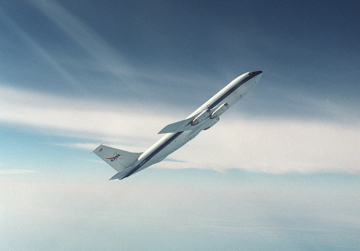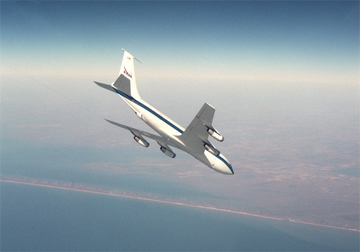

What is the Reduced Gravity Flight?
NASA's Johnson Space Center in Houston, Texas, houses a microgravity research aircraft, a KC-135 (a predecessor of the Boeing 707 which is typically used for refueling military aircraft) affectionately called "The Vomit Comet." The KC-135 is a four-engine turbojet. It is used to fly a parabola to investigate the effects of "zero" gravity.
The plane is flown out over the Gulf of Mexico, climbing to around 24,000 altitude above mean sea level (MSL) and 350 knots indicated airspeed (KIA). The yaw and roll autopilots are engaged, and the pitch axis autopilot is disengaged. The pilot then pulls the nose up steadily to a maximum of 1.8 G (equal to 1.8 times the normal gravitational pull felt at earth's surface), pitching up to 45-50 degrees. The airspeed drops off. The pilot pushes the stick forward and comes back on the thrust, taking the two outboard engines to idle, while the thrust of the two inboard engines control the fore/aft acceleration to zero. The pilot watches the reading on the accelerometer, using minuscule control inputs to keep it at zero. Over the top of the parabola, the pilot pushes the stick forward to hold the acceleration to zero. The top of arc comes at 34,000 MSL, with 150-170 KIA. The pilot continues to pitch over until the aircraft is 45 degree nose down. Thrust is steadily increased until back to 350 KIA, at which point the pilot pulls back on stick, bringing acceleration up to 1.8 G. The maneuver ends back at 24,000 MSL, 350 KIA. Wind from the nose or tail varies the parabola somewhat.
Each flight, which lasts about two hours, usually involves around 40 parabolas.
What preparation will the flight team take?
The RGUT members who fly on the KC-135 will train for and receive a valid Air Force Class III medical, with NASA Physiological Training (which consists of an eight-hour course and a high-altitude chamber run for hypoxia symptom training).
The day of the flight, team members are asked to eat only citrus (probably the most least vile smelling food if vomited). There is a preflight safety video which reminds fliers about safety equipment and procedures. After the video, the fliers are issued flight suits, heavy boots and "air sick bags". Most of the fliers will also take an anti-nausea medication, Scop-Dex, a mixture of scopalamine and dexadrine.